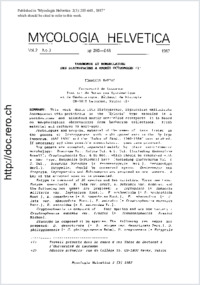Taxonomie et nomenclature des Diatrypacées à asques octosporés
- Rappaz, François Institut de Botanique Systématique, Université de Lausanne, Suisse
-
1987
Published in:
- Mycologia Helvetica. - 1987, vol. 2, no. 3, p. 285-648
English
This work deals with Diatrypaceae, lignicolous unitunicate Ascomycetes with perithecia of the "Xylaria" type embedded in a pseudostroma and allantoid mostly one-celled ascospores. It is based on morphological observations from herbarium collections, fresh material and cultures on malt-agar.Protologues and original material of the names of taxa listed in the genera of Diatrypaceae with eight-spored asci in the "Sylloge fungorum, 1882-1931" and the "Index of fungi, 1940-1984" were studied.If necessary and when possible nomenclatural types were proposed.Six genera are accepted, separated mainly by their entostromatic morphology: Diatrype Fr.; Eutypa Tul. & C. Tul. (including Endoxylina Romell); Cryptosphaeria Ces. & De Not., which should be conserved with a new type; Eutypella (Ni tschke) Sace. ( including Quaternaria Tul. & C. Tul., Scoptria Nitschke (= Peroneutypella Berl.), Peroneutypa Berl.). Eutypella, should be conserved against Quaternaria and Scoptria. Leptoperidia and Echinomyces are proposed as new genera. A key of the accepted species is presented.Eutypa is composed of 26 species and two varieties. Three new taxa: Eutypa quercicola, E. lata var. aceri, E. petrakii var. hederae, and the following new names are proposed: E. leptoplaca ( = Sphaeria milliaria var. leptoplaca Mont.), E. orthosticha (=S. orthosticha Mont.), E. consobrina (=S. consobrina Mont.), E. abscondita (= S. lata var. abscondi ta Mont.), E. petrakii ( = Cryptosphaeria moravica Petr.), E. astroidea (=S. astroidea Fr.).Cryptosphaeria is composed of four species and one new variety : Cryptosphaeria eunomia var. fraxini (= Trematosphaeria fraxini Richon).Diatrype is composed of 56 species. The following new names are proposed: D. decorticata (= S. stigma var. decorticata Pers.), D. philippinensis (= C. philippinensis Rehm), D. oregonensis (= Eutypella oregonensis Wehmeyer), D. euterpes (= E. euterpes Henn.), D. implicata (= S. implicata Lév.), D. patagonica (= E. patagonica Speg.), D. praeandina (= E. praeandina Speg.), D. petrakii (= E. canariensis Petr.), D. leucostroma (= S. leucostroma Mont.), D. bermudensis (= Eutypella linearis Vizioli), D. urticaria (= S. urticaria Mont.), D. arundinariae (= Eutypella arundinariae Berl.), D. phaselinoides (= Eutypa linearis Rehm), D. phaselina (= S. phaselina Mont.), D. aemula (= E. aemula Penz. & Sace.).Eutypella is accepted with 76 species and one variety, the following new names being proposed: Eutypella paraphysata (= Eutypa paraphysata Speg.), El. ludens (= E. ludens Speg.), El. riograndensis (= D. riograndensis Rehm), El. doryalidis (= D. doryalidis Doidge), El. aspera ( = Qua ternaria aspera Massee) , El. ambiens ( = Peroneutypella ambiens H. & P. Syd.), El. gymnosporiae (= D. gymnosporiae Gambhir), El. combreti (= E. combre ti Gambhir), El. ruficarnis (= D. ruficarnis Berk. & M. A. Curtis), El. rimulosa (= Cryptosphaeria rimulosa Pass.) , El. velata (= D. velata Re hm) , El. erythrinicola ( = E. erythrinae Speg.), El. dissepta ( = S. dissepta Fr.). El. quaternata (= S. quaternata Pers.), El. hunanensis (= Quaternaria microspora Teng. & Ou), El. capensis (= El. lycii Doidge non Ade), El. arecae ( = Peroneutypella arecae H. & P. Syd.), El. corynostomoides ( = Pl. corynostomoides Rehm), El. curvispora ( = Cryptosphaeria curvispora Starb.), El. portoriciensis (= Peroneutypa portoriciensis Petr.), El. comosa (= E. comosa Speg.).Leptoperidia is composed of four species: L. macropunctata (= E. macropunctata Re hm) , L. tri fi da ( = D. tri fi da Ellis & T. Mac br.) , L. asperrima ( = Peroneutypa asperrima Syd.) , L. applana ta (= Peroneutypella applanata Syd.), and Echinomyces of two species: Ec. obesa (= Peroneutypa obesa Syd.), Ec. echidna (= Valsa echidna Cooke).Dothideovalsa Speg., composed of three species, and Rostronitschkia Fitz. (one species), are provisionally accepted in the Diatrypaceae, but their relationship still needs to be clarified.A list of doubtful, rejected or not examined species is given and the names proposed for the anamorphic genera are briefly discussed.
- Faculty
- Faculté des sciences et de médecine
- Language
-
- French
- Classification
- Biological sciences
- License
-
License undefined
- Identifiers
-
- RERO DOC 29136
- Persistent URL
- https://folia.unifr.ch/unifr/documents/302452
Statistics
Document views: 390
File downloads:
- pdf: 749
